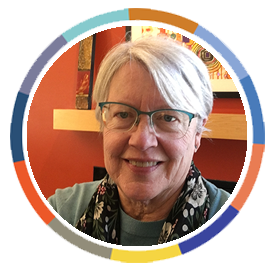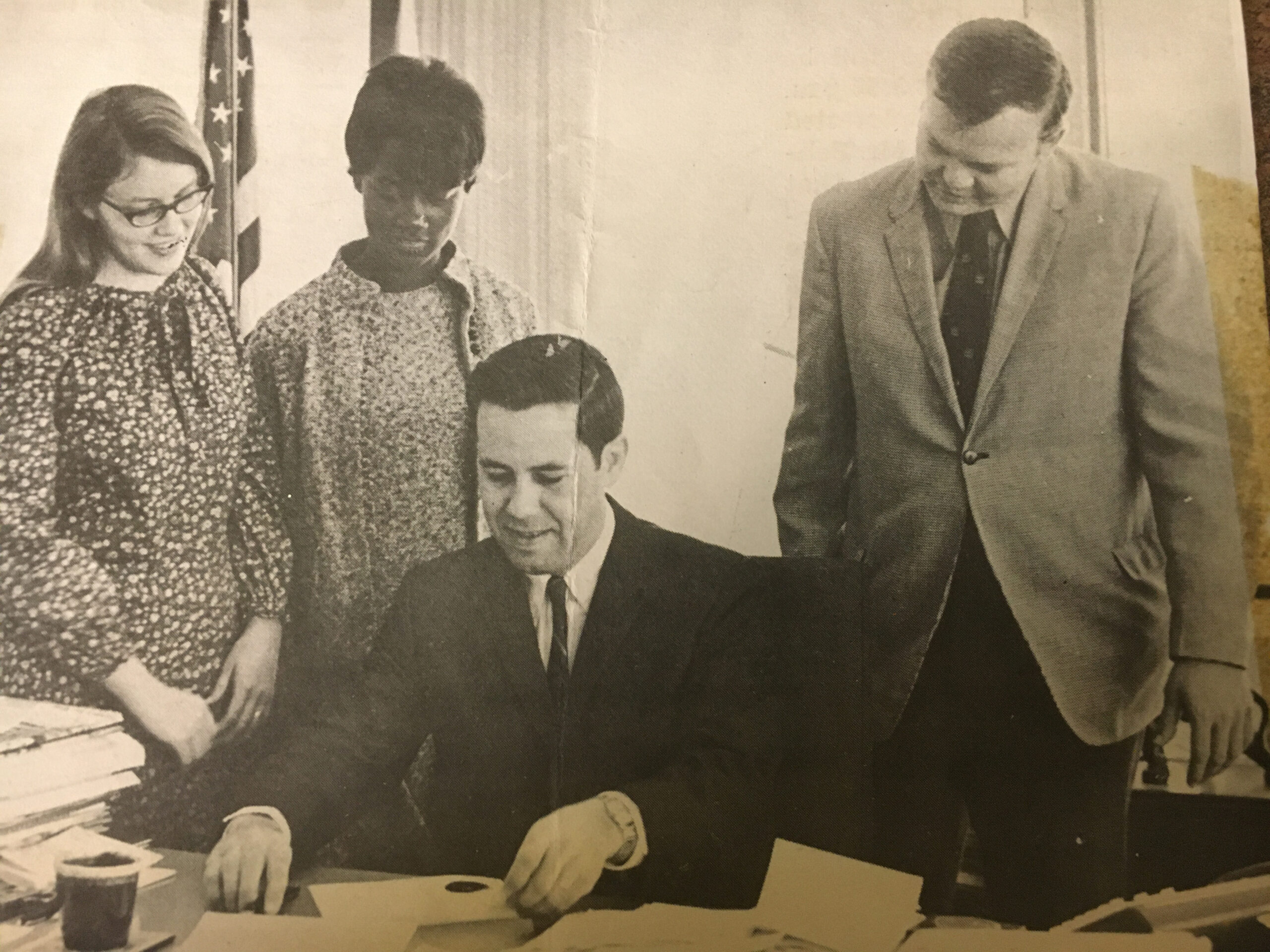
PATRICIA READ
I grew up the middle child in a middle-class family in the middle of the country in the middle of a period of significant social change. For me, the 1960s started with great optimism and excitement as we ran to see the young incoming President, John F. Kennedy, as he rode in the back of a powder-blue convertible waving wildly as his motorcade sped by our home. The very next year, the Klu Klux Klan shattered that optimism when they attacked the home of the first black family to move into our neighborhood, burning crosses on their lawn, throwing paint on their car, and writing horrible words on the sidewalk. From that point on, as I was “growing up,” I had to learn to find “balance” between moments of great joy and terrifying tragedy, learning to understand and empathize with what others were feeling and experiencing, and discovering who I was and what I believed amidst all of this.
- Finding Balance in the Middle
- The Core Values Set From Home
- “Women’s Lib”
- Politics, Passion And Social Justice
- Seeking Some Balance
- Looking Back and Forward
Finding Balance in the Middle
I grew up the middle child in a middle-class family in the middle of the country in the middle of a period of significant social change. For me, the 1960s started with great optimism and excitement as we ran to see the young incoming President, John F. Kennedy, as he rode in the back of a powder-blue convertible waving wildly as his motorcade sped by our home. The very next year, the Klu Klux Klan shattered that optimism when they attacked the home of the first black family to move into our neighborhood, burning crosses on their lawn, throwing paint on their car, and writing horrible words on the sidewalk. From that point on, as I was “growing up,” I had to learn to find “balance” between moments of great joy and terrifying tragedy, learning to understand and empathize with what others were feeling and experiencing, and discovering who I was and what I believed amidst all of this.
The Core Values Set From Home
My parents shared a commitment to hard work, education, social justice, and the value of the arts.
My parents expected that my brothers and sisters and I were all work from an early age, delivering newspapers, babysitting, doing yard work, and engaging in a host of entrepreneurial ventures. Living across the street from the state fairgrounds provided us many opportunities to sell lemonade and our hand-painted jewelry crafted from the beautiful buckeyes we collected from neighborhood trees. We were excited to take our savings passbooks to the bank and watch “the bottom line” grow, knowing that would ultimately help pay for the college education that was always assumed to be our natural course.
My mother made sure we were able to take piano and ballet lessons by pinching pennies and serving as “chauffeur.” For us, she denied herself any sort of “niceties.” You didn’t see many boys taking ballet at the time. So, why did my mom enroll my brothers in ballet? She believed that ballet would add to their grace and athletic prowess – and it did.
Music and art were an essential part of our public school education from first grade through high school. How important did these courses turn out to be for us? My older brother became a musician; my older sister, a ballet dancer and teacher.
We were all encouraged to engage in sports, and my father volunteered as a softball coach for all of us when we were young.
I tried hard but was never very successful at sports. In my first softball season, I earned the “most improved” title because I had so much room for improvement! Living in a state where basketball is almost a religion, sports would play a crucial part in much of my high school years too, but I get ahead of myself.
Religion played an essential role in our family. But most of our friends and classmates viewed our religious traditions suspiciously. My mother was a devout Catholic when she fell in love with a divorcee at a time when the Catholic church did not recognize divorce and forbade their marriage.
Fortunately, “love” won, and my parents found a new spiritual home in the Unitarian Universalist Church that welcomed people of many faiths and required only that members “seek the truth in love …and help one another.”
My father joined the choir and became the church treasurer, while my mother became active in teaching Sunday school, where we studied the religions of the world from ancient times to the present.
As the sixties progressed, this “liberal” church presented challenges for me. While the world was shaking around me, I yearned for more certainty and more precise rules and direction. My parents permitted me to attend Catholic mass with my cousins and explore many different religions. I launched a lifelong effort to define and live my faith, even when it didn’t fit with my friends’ and classmates’ and “popular” positions.
The core principles of Unitarianism, and the strength of that loving community, have remained a strong support throughout my life. They sustained me when I lost my parents and supported me in my marriage.
“Women’s Lib”
One of my summer jobs was in a factory/production unit for a company that produced continuing education materials on insurance. A few women were among the “permanent” employees, but I was the only girl in the summer cohort. When I discovered that the boys earned $1.25/hour more than I was, I was furious and protested to my boss, who explained that they deserved the higher rate because they could climb shelves to do inventory counts and lift heavy boxes. You can only imagine how motivated I was to prove him wrong! My pay rate was increased a few weeks later when I passed the test, but I never reached parity and got a lot of grief from my male co-workers and even some of the older women who weren’t happy that I was challenging the system. Those were indeed days when girls had to fight for anywhere near equal treatment – but I didn’t think of it as “women’s lib” or “feminism” until after college.
Politics, Passion And Social Justice
Indiana was a hotbed for the Ku Klux Klan, which ruled the state in the 1920s and still has a stronghold in some parts of the state. Schools were segregated from the 1920s until sometime after the Supreme Court ruled in Brown v. Board of Education. My high school, Shortridge High School, was the oldest public high school in Indiana and was the first to admit an African-American student in the late 1800s. It counts many illustrious figures among its alumni, including the author Kurt Vonnegut and the late Senator Richard Lugar. No black students were permitted to attend over the 30 years when segregation was the law, but that changed rapidly beginning in the late 1950s.
By the 1960s, the U.S Department of Justice had threatened Indianapolis with a lawsuit over de facto segregation, and the school board was searching for a solution that would stave off such a suit. The school board’s answer was to convert Shortridge into a magnet “academic prep” high school where all students would be required to have average grades and scores on academic achievement tests to apply for acceptance.
The Class of 1970, my class, was the first to enter under this new plan, and the class was very small and fairly evenly distributed between white and black students. More importantly, the students shared a desire to see the plan work. Our shared passion strengthened our bonds.
Exploring the roots of racial and social injustices was a theme from our freshman year forward. The phenomenal Roy Aberson, who coached track and field and was the faculty liaison behind the Human Rights Council, put together an all-school conference on extremism where we heard debates between a representative of the NAACP and the Ku Klux Klan, a representative of the ACLU and the John Birch Society. I have so many vivid memories of that day, people of different races and religions having a civil discussion that taught us so much about maintaining dignity while fighting oppression and injustice.
In part due to Mr. Aberson’s support and in part due to the horrible attacks against those fighting for civil rights in the South occurring at that time, a cadre of student leaders grew stronger over the next few years in fighting for many changes, including expanding the American history and literature curriculum to include black authors like Langston Hughes and James Baldwin and to cover the history and contributions of African Americans.
Sophomore year – 1967-68 – was perhaps the most tumultuous of all. Our basketball team had incredible success, rising to the state basketball championship finals, the pinnacle of stardom in Indiana, and we attended every single game. Viet Nam was becoming a major controversy as we watched many of our brothers and friends get drafted or find ways to escape to Canada. Indiana was at the center of the lead-in to the presidential election of 1968, and I joined friends in getting involved in presidential politics, even though we were far from voting age. As a true Kennedy-kid, I was drawn to and volunteered for Bobby Kennedy, who I believed was the only candidate who not only opposed a war I thought was unjust but who also understood and fought for civil rights. Music and theater were also a big part of my life that year, and on April 4, those different sides of my life came together in a night I will never forget.
That night, the Girls Ensemble that I was part of was performing at a celebration for our winning basketball team at the Marott Hotel. We were very excited that Senator Kennedy would also be staying at that hotel before speaking at a rally in a downtown neighborhood. When we finished our performance, we raced to the lobby, hoping to catch a glimpse of the Senator. There was an ominous hush as he descended the staircase and stopped to tell us that Martin Luther King Jr. had been shot and killed in Memphis. I still get chills when I write and remember that night and the powerful speech Senator Kennedy gave at the rally.
The next few days were fraught with tension, anger, and occasional fights in the school hallways. Many protests followed over the next few years. In one egregious example, school administrators confronted a fellow student for wearing a t-shirt with a clenched black fist and ultimately administrators suspended the student and called the police to arrest him. This incident touched off further protests that led to an ugly encounter between students and police that grew violent.
These altercations forced my friends and me to think through how we could make a difference and fight oppression even though we were not as brave or willing to take on the authorities as some of our fellow students. I continued volunteering for Senator Kennedy’s campaign through his victory in the Indiana primary and, like so many others, was devastated when I woke up on June 6th to the news of his assassination.
That summer, I went to Chicago to help my aunt take care of my twin cousins, then 4-years old. While there, I headed off with my cousin, who was just a few months younger than I, to see what was going on at the Democratic National Convention. We quickly became engaged in an effort to draft Senator Ted Kennedy instead of handing the nomination to Senator Eugene McCarthy and Hubert Humphrey, who were the front-runners and who we fervently opposed. Julian Bond who was then a Congressional Representative from Georgia and one of the leaders of the effort to challenge the nomination process, trained and directed us. He also was the person who sent us home when he foresaw the police attacks against the Yippie protestors in Grant Park.
Seeking Some Balance
As we started our junior year, we teetered between the “normal” high school life of dances, music, studying, and dating and the continuing political tensions and unrest surrounding us. I was elected to chair the “Junior Vaudeville,” an annual show of one-act plays written and directed by juniors and involving students from all classes, which occupied much of my time and attention. I had to overcome my natural shyness and stage fright to take on that leadership role. Some of those lessons were invaluable in my later professional life as a lobbyist and political activist.
By my senior year, the city was embroiled in further battles over school desegregation and decided to end the “Shortridge experiment” effective with our graduation. We attended endless school board meetings, wrote letters, protested, and our music director (a huge fan of the Mod Squad for those of you who remember that infamous TV show) decided to put together a major concert to show off the power that was Shortridge. We students sold over $20,000 worth of candy to pay for the Indianapolis Symphony and four Metropolitan Opera soloists to join us in s performance of Verdi’s Requiem at Clowes Hall, Indianapolis’s version of the Kennedy Center.
The over 100 members of the choir had to learn their parts so well they could stand up and sing any section in a quartet at a moment’s notice.
I will never forget this experience.
For me, it was a lesson about the importance of striving for perfection and reaching for the stars. That experience and lesson continued to drive me and many of my friends through all types of my life challenges.
It was a powerful way to end the decade.
Looking Back and Forward
The 1960s brought me into contact with a fantastic group of fellow students who became my friends, mentors, and heroes.
I learned from them then and as the years unfolded, I became aware of and was awe-struck by their many achievements. I’m so looking forward to seeing many of them again at our now much- delayed 50th reunion celebration.
If you are enjoying The 1960’s Project, please consider making a contribution to the…

